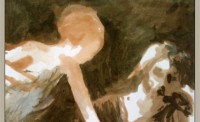25 Points: Brushes With
 Brushes With
Brushes With
by Kristina Marie Darling
BlazeVOX [books], 2013
50 pages / $16.00 buy from BlazeVOX or Amazon
1. This is Kristina Marie Darling’s 11th book of poetry; she is not even 30 years old yet.
2. Darling eschews traditional forms of poetry in favor of her own unique formal constraints: the use of footnotes, appendixes, images, definitions, bracketed verse, and erasure poetry. However, in Brushes With, Darling adds a new form to her repertoire: the narrative prose poem.
3. The collection begins: “We were no longer in love. The sky, too, was beginning to show its wear.” From this point forward, readers are plunged into many complex layers of the rubble of abandonment and loss.
4. The footnotes serve as historical commentary on the prose text. This makes for a matrix-like experience. We are reading a person’s intimate words, but we also know that this text has been abandoned, then found, then studied, then put on display. This technique makes the experience of reading the prose poems feel illicit in some way. We are peering into a labyrinth of secrets that are not meant for our eyes, yet are now uncomfortably preserved and public.
5. Even while reminiscing on the relationship before its end, the speaker foreshadows doom: “You told me there was dark matter I couldn’t see. That every star is a dead star.”
6. The imagery, like the one above, proves to be richly complex. All stars are dead; therefore, that which enchants us, that which we wish upon, that which we map out, gaze upon, pray to, is also doomed. In every romantic union, there is something dark that we don’t see coming, yet we should be aware that it’s there.
7. In “Feminism,” the speaker states: “I began to realize the significance of this gesture. What is love but a parade of memorable objects, a row of dead butterflies pinned under glass?” Ouch!
8. The speaker’s take on love is relentlessly jaded, yet she comes to sharp edged truths. What is love but our desire to possess, collect, admire. Yet, in doing so, we must sacrifice the subject’s life.
9. Footnote 18. ‘This statue of the Holy Mother would later be found headless in a tiny museum in northern France.” Once again, we have worship, mementoes, collection, ownership—all leading to destruction. Facelessness.
10. The marriage documented in the book unravels due to affairs. READ MORE >
August 20th, 2013 / 5:22 pm
